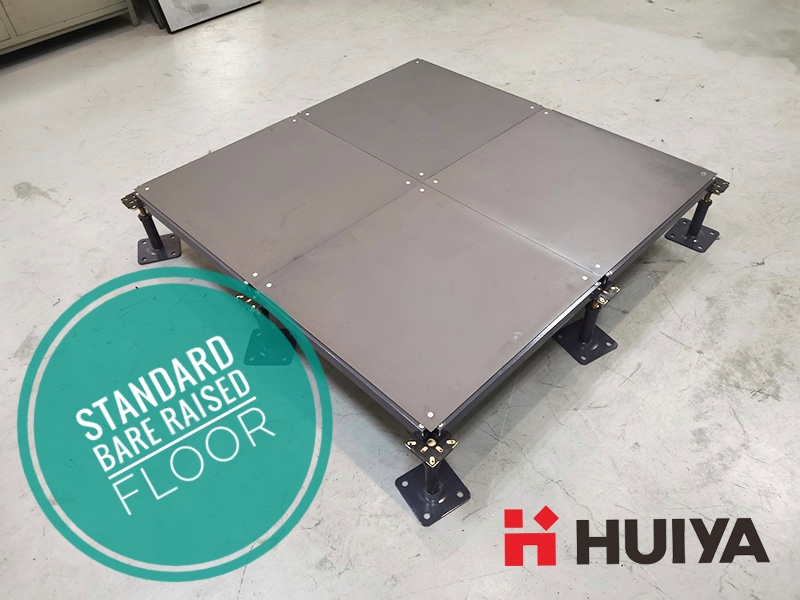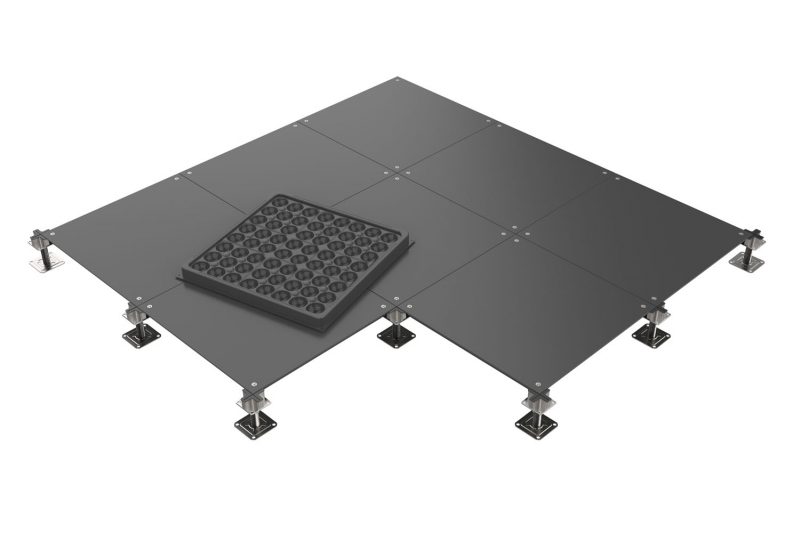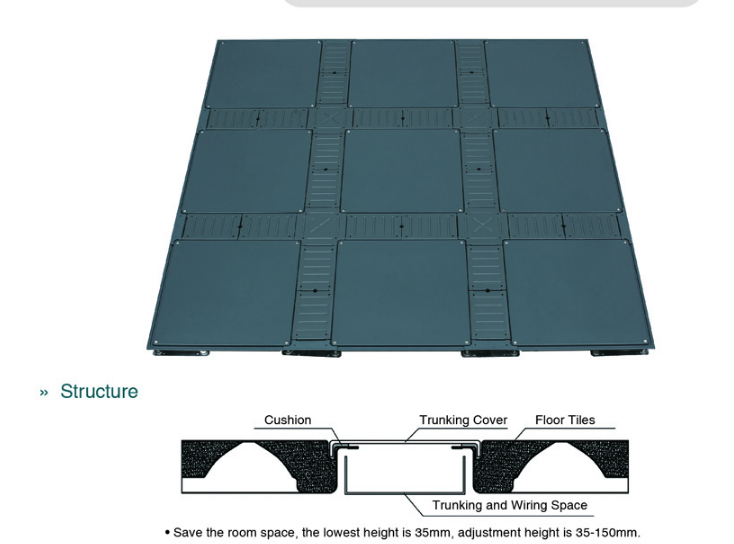
You’ve all seen the articles about “coolest offices in the world” but never thought of having one? Raised floor, one of the pioneer prerequisites for a modern office, has become pretty much a standard these days to give an “all-new” inspiring aura to any space. Today’s office is all about creative and unique workplaces, and a raised floor system certainly paves the foundation to keep the space interesting. It does accentuate organized and inspiring environments – where simple office space can easily adapt to high-quality tech needs and leisure facilities. Amidst no hassle of wiring or mechanical fitting, the underneath void provides you with the gateway to fulfill your electrical, mechanical, and HVAC needs and even more. You save an abundance of space.

Raised flooring solution is known by many names globally – access floor raised access computer flooring. To map it out in simple words, it is an elevated floor constructed above a building’s original concrete slab surface, thereby creating an underneath hidden void (between the two floors) that can be used for meeting mechanical and electrical services.
In order to design your first-ever modern office, here are the key aspects to get started…
#1 Decide the Type of raised floor -
#2 Raised floor application depending on several considerations
A traditional raised floor is more like an outmoded access floor broadly used on old buildings for underfloor air distribution. Most of the traditional raised floor format is outlined by Construction Specifications Institute (CSI) and Construction Specifications Canada (CSC) specification. The standard type of traditional raised flooring include:
The traditional raised access flooring system was first introduced in 1960 to fulfill the cooling & airflow need of large computer mainframes. Unfortunately, these high-end mainframes often become hot – ultimately resulting in malfunction and poor working conditions. Through a traditional access floor, one can accommodate underfloor air distribution (UFAD) via plenum.
The plenum height is determined by the volume of cables, electrical, mechanical, and HVAC requirements, which must be stored underneath the raised access floor. The typical height of the plenum is somewhere ranging from 6 inches to 4 feet or higher, depending on the organizational requirements.
Yes, this is broadly known as the low-profile raised floor. Some raised floor manufacturers (like HUIYA) even attempt to bring raised floor height down to 4 inches or even less. This is perfect for a space with minimal tech requirements and fits the budget of many entrepreneurs.
Bear in mind: at 4 inches or less height, a raised floor might not be able to meet your future tech requirements. The limited space doesn’t offer utmost flexibility and practicality with shifts in technological, electrical, or mechanical needs. In order to meet consistent industrial demand, we’d recommend going for a high-profile raised floor system.

After the pavement of raised flooring, it all comes down to aesthetic and final look. The raised floor panels can be covered with a variety of flooring tiles, for instance – vinyl tiles, carpet tiles, HPL, rubber tiles, hardcore wood, marble, and ceramic tiles.
If repair or changes are deemed necessary, consider a professional raised floor installer to improve the performance standard of a raised floor system. They are highly trained and well-equipped with the tools (floor-puller, tile lifter, or suction lifter) necessary to open the raised floor with brute force.
Structural problems – The raised floor is constructed on a smooth surface. Any imbalance could result in a structural problem such as rocking panels or gaps between the raised floor panels. The structural problem can cause significant damage to machines and equipment — and sometimes leads to unexpected injuries. Hence, before installation, one must look out for problems or get an inspection done by a certified installer to anticipate structural integrity. This assessment will help you to identify and dodge any problems before they cause significant damage.
Most of the problems can be fixed during the early stages of the planning process. If the installation is done correctly, a raised floor will serve its purpose for almost a decade. For well-thought planning, you must pay special attention to the subfloor condition. It should be accurately leveled and clean of all debris. Bear in mind that the surrounding wall near the raised floor system needs to be as square as possible. This would minimize the need to cut the panels, panel rocking, and gaps.
Other than all these, you must also pay attention to the load demand - & equivalent specification. If the raised floor fails to meet a prerequisite load demand, it will collapse the workplace. The load ratings for the raised floor range somewhere between 1000 and 25000 pounds. One can consider installing a lower weight panel in the light load area of the office and subsequently using higher weight panels in a heavy load area.
To put it in simple words, a traditional raised floor panel is a smart fit for an office with a heavy-duty system (like HVAC). We would recommend hiring highly-trained personnel to do the flawless installation and necessary service of the raised floor system.
The traditional raised flooring can be quite difficult to handle, particularly during maintenance. Since the individual panels are bulky and require special tools to lift & access the plenum, traditional raised flooring becomes a hassle to access the wires, cables, and pipes. Furthermore, it's not advised to lift too many panels at one – as it could lose stability and collapse the entire system. This could result in a major problem.
Is there a solution? Yes, one can opt for other types of raised flooring systems that are lightweight and far less complicated than the traditional post and panel model. These alternatives are primarily suitable for telecommunications/data center applications and easily fulfill the demand of modern offices.
In a world of unique technological requirements, raised access flooring is broadly used in IT space, data centers and computer rooms i.e., where there is a necessity for UFAD. All cabling and wiring are routed through the underfloor space.
A telecommunications space consists of continuous line-ups of equipment cabinets. The same goes for data centers where we often witness populated installation configuration and requirement of the heaviest floor load expected for a raised floor system.
Furthermore, the traditional raised floor serves as the backbone of data centers, a domain subject to physical and electrical stresses from sources such as fires, ESD, and electrical faults.
In numerous data centers, a raised floor is broadly chosen for air-conditioning zones. In order to enhance the efficiency and channel cool air directly into them, perforated floor tiles are positioned underneath the computer systems.
In the dynamic business environment, a traditional raised floor is not are not used in a telecommunications/data center setting. Instead, several different types of raised flooring solutions can be installed to consequently meet the demand. For example:
Low profile raised floor is broadly accredited as Cable Management Distribution Raised Flooring System. CSI and CSA have accredited Low profile raised floor a newer generation of raised flooring systems. The applicable model number is:
09 69 33 – Low Profile Fixed Height Access Flooring
For more than 50 years, the traditional raised floor has been seen as the only raised floor that supports the same purpose today, i.e., air distribution. However, with the advent of information technology in the early 21-st century, a low profile raised floor is seen as a modern building prerequisite. Seeing the fact that most organization doesn’t need heavy-duty mechanical, electrical and wiring needs, a low profile raised floor serve the purpose very well. It kickstarted like a fire, and it was perfectly suitable for modern business premises with no/minimal air distribution need.
So is a low-profile raised floor a replacement for a traditional raised flooring system? Yes, in most cases, a low-profile raised flooring serves as a perfect alternative to a high profile/traditional raised flooring system. Low profile raised floor is globally appreciated for its flexibility and adaptive solution for cable management.

The 21st-century modern offices look for the most sophisticated, value-driven, and long-standing solution for their building & office premises. Low Profile Raised Floors fits like a glove in this segment – enable entrepreneurs to quickly and easily make necessary changes to their floor plan and technological configurations. Some unforeseen benefits of a low profile raised floor system are:
This type of raised floor system works best for the following industries: call centers, healthcare, command center, offices, laboratories, libraries, and classrooms.
Bear in mind: not all low-profile raised floor systems are the same.
The 21st-century modern offices look for the most sophisticated, value-driven, and long-standing solution for their building & office premises. Low Profile Raised Floors fits like a glove in this segment – enable entrepreneurs to quickly and easily make necessary changes to their floor plan and technological configurations. Some unforeseen benefits of a low profile raised floor system are:
Movable and customizable.
Low profile raised floors are lightweight, built with modular components, and the flooring architecture can be adjusted or modified according to the office needs. With the advent of new technology, the raised floor can be added/adjusted to the existing system without putting financial strain on your pocket. Low profile raised floors can be quickly opened up to add new cables. Low profile raised floor space is a trendsetter and broadly used by Fortune 500 companies. It helps in facilitating the reconfiguration of space in less time and with greater ease.
Improves safety and cleanliness:
Safety & hygiene is always a priority. Low profile raised flooring hides trouble-causing cables underneath the floor, are hidden from sight, and eliminates the tripping hazards. The underneath space can be used to manage cables safely and promotes a clean, professional surrounding.
Cost-effective.
Low profile raised floor is cost-effective compared to traditional flooring. Once installed, it will serve the purpose efficiently for almost a decade. Besides, unpacking a low-profile raised floor is relatively simple & straightforward – and doesn’t require extensive human resources work. It is easy to detach and hassle-free to relocate.
Maximizes vertical space:
Low profile raised floor is the no one choice for many architects and property managers. This is because – with low profile raised floor, a designer can think beyond traditional raised flooring solutions and have a designer panel to make it look appealing. Low profile raised floor system is the most practical access floor solution available in the market, particularly for buildings that cannot afford to lose ceiling height. Nearly all size companies can benefit from low profile raised access floor.
What industries are benefitting from a low-profile raised floor system? This type of raised floor system works best for the following industries: call centers, healthcare, command center, offices, laboratories, libraries, and classrooms.
Bear in mind: not all low-profile raised floor systems are the same.
The most revolutionary, adaptive raised floor system for cable and power management. GRIDD Raised Access Floor bridges the gap between the architects and IT. All steel-constructed low profile raised flooring can be assembled and installed in seconds. Since it is supported by gravity, the configuration, designing, and deploying is relatively easy. This state-of-the-art engineering design is literally changing the access floor industry.
GRIDD fulfills the demand for low profile raised floor by meeting the needs of flexible design, contemporary buildings, and technology change. HUIYA leads the segment by constructing a bespoke low profile raised floor system and is globally accredited as the premium section of the raised access floor.
Today’s modern workplace offices are not only about pen & paper. They need a space to fulfill power, voice, and data equipment requirements —and that eventually onboards large numbers of wires, cables, and connection points. It wouldn’t be wrong to say that offices have evolved tremendously over the past two decades. “New Technology Demands Pioneering Workplace,” i.e., more flexibility and adaptability in raised floor design.
Furthermore, it's more than design – most corporate offices prefer to retain the power to change the layout by constantly changing structural codes in building designs and architecture. In order to accommodate the ongoing trend toward the open office and portable furniture, the raised floor must be thoughtfully planned for an adaptive cable management system.
Now, let’s discuss Gridd in detail…
Gridd 40 of 1.6 inches (40 mm) height
Gridd 70 of 2.75 inches (70 mm) height
Both Gridd models are manufactured from 16-gauge zinc galvanized steel and following specification:
Base unit: 370 mm x 370 mm (14.6” x 14.6”)— overall weight is 1.5 pounds.
Corner Plate (for Gridd40)— Reinforced Corner Plate (for Gridd70)
Channel Plate (for Gridd40)— Reinforced Channel Plate (for Gridd70)
Under Sheet design standard
Border Mechanisms: Quarter Unit, Half Unit, Half Channel Plate, End Cover, L Type Border, Reinforcing Band, Trapezoid Plate, L Type Trapezoid Plate
GRIDD 40 raised floor can support 50 CAT 5 cables in every 15 inches @ 40% capacity— which is more than enough for any office.
GRIDD raised flooring is though very lightweight, it is 3 X stronger.
Each GRIDD base unit is outfitted with 34 legs which give the raised floor integral support and stability.
GRIDD is 100% steel, eco-friendly, recyclable, and has no plastic components whatsoever.
GRIDD is the next-generation raised floor solution that provides the organization of an innovative cable wiring solution within the floor and is entirely geared towards improving efficiencies in power & data delivery. GRIDD raised floor also provides a subtle separation of secured and unsecured electrical wiring (NIPR/SIPR).
The installation phase of GRIDD Raised Floor is easiest, straightforward, and can be completed in rapid turnaround time. It is the fastest raised floor solution available in the market for any business. A single installer can install GRIDD raised floor at the rate of 1,000 square feet per day.
STEP 1 - A non-combustible foam Sheet is laid out to cover up the entire concrete slab. This further helps in keeping the system noiseless and stable.
STEP 2 – The steel base units with 34 legs are disseminated along with Channel Plates and Corner Plates. The installation phase doesn’t require any pedestals, glues, screws, or fasteners. The entire floor is held firmly by gravity.
STEP 3 – The remaining space is filled with adjustable border components. The raised floor system is further outfitted with ramp systems and electrical components.